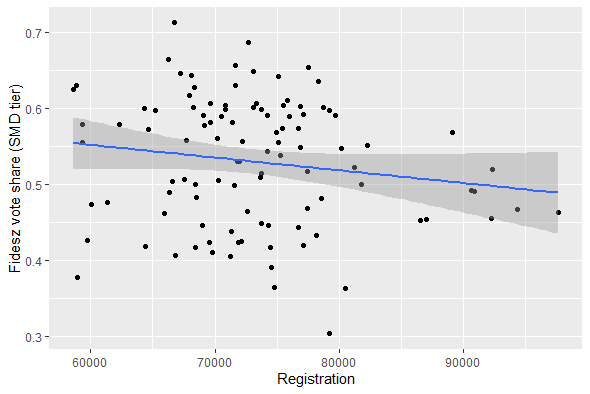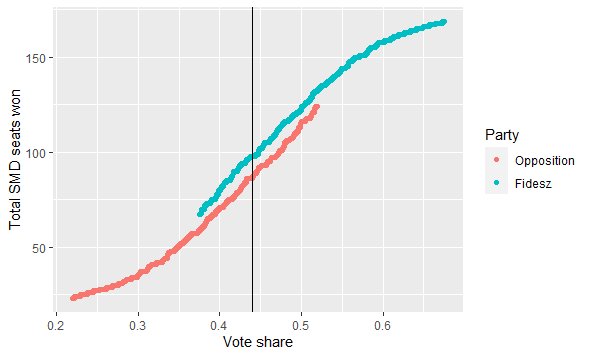Hungary’s 2022 election resulted in an overwhelming victory for the incumbent Fidesz party, led by Prime Minister Viktor Orban, against a broad opposition coalition, led by Peter Marki-Zay, comprised of liberals, social democrats and the nationalist Jobbik party. Orban’s twelve-year-long government has been the focus of international attention over its nationalist policies and weakening of democratic institutions.
One of the earliest initiatives of Orban’s government was a set of amendments to the electoral law in 2011. While Hungary retained a mixed-member system, the three-tier system introduced in 1989 was replaced with a two-tier system. The size of the legislature was cut drastically, from 386 to 199. This involved a redrawing of the single-seat districts, as the number of these districts fell from 176 to 106: the two-round system previously used for these seats was replaced by first-past-the-post.
The process of drawing new electoral boundaries and introducing a new electoral system represents an excellent opportunity for a governing political party to entrench its own advantages. Fidesz had a completely free hand in that process, owing to its two-thirds constitutional majority. So, what does the electoral system look like?

Based on the 2022 results, there is a clear negative relationship between Fidesz vote share and registration numbers. Interestingly, this is driven by very high registration in the electoral districts of suburban Pest county, which is the cluster on the right of the plot: Budapest, the opposition’s stronghold, has roughly average enrolment.
But what does this mean in terms of actual election results? In order to examine this, I simulated a set of uniform swings1 between Fidesz and the Alliance for Hungary. The below plot shows seat totals in the single-seat districts at different vote shares for both the opposition alliance and Fidesz (vote shares for the other parties were kept constant).

The vertical line shows where the two parties tie – approximately 44% of the vote each, or a swing of 7.8% towards the opposition. At this level, Fidesz would win 56 single-seat districts to 50 in total for the opposition. In order to win a majority of the single-seat districts, the Alliance would need approximately 46% of the vote to 43% for Fidesz.
Of course, the list seats need to be taken into account. The below plot shows the number of total seats each party would have won with the same vote shares as in the prior plot. The vote share for the other parties is held constant, and I assume that the nationalist My Homeland party would have held onto its 5% of the vote and 6 seats, and that the German minority would have elected its single member under the special procedure for ethnic minority parties.

The effect of the list seats is fairly minor. A tied vote would give the Alliance 91 seats to 100 for Fidesz, the slimmest of absolute majorities. Fidesz loses this majority at a fractionally lower share of the vote. However, for the opposition to win a plurality, they need about the same 46-43 vote share as they need for a majority of the single-seat districts, and to win the 100 seats required for an absolute majority they need 47% of the vote to 42% for Fidesz.
How serious is this effect? How does it compare to other jurisdictions? One method which has received some use in the (inevitably US-centric) gerrymandering literature is the ‘efficiency gap’, which calculates the difference between the number of wasted votes for the two major parties, as a proportion of all votes. I calculate the efficiency gap at this election to be 5.2%, again ignoring votes for minor parties. According to the paper laying out the efficiency gap measure, this gives Hungary a map roughly as biased towards Fidesz as the maps in Minnesota or South Carolina were towards the Republican Party, or the map of California was towards the Democratic Party. Hungarian bias, however, does not seem to be as strong as that in North Carolina or Florida.
Hungary’s 2012 electoral map, then, provides Fidesz with a modest but meaningful electoral advantage, only slightly ameliorated by the list tier. Nonetheless, the opposition at this election achieved a vote share well short of what would be needed to win a majority. Unlike in Poland, the role of the electoral system in the installation of this government has been seemingly fairly minimal.
1 Note that ‘swing’ is here defined as percentage points subtracted from Fidesz’s (or the opposition alliance’s) vote and added to the opposition alliance’s (or Fidesz’s) vote share. I believe this is the Australian definition, as opposed to a British one that (I think) averages the two figures.

The FPTP tier is biased towards Fidesz, but I doubt deliberate gerrymandering played a key role, I think it is merely a consequence of the inefficient concentration of opposition votes in strongholds like Budapest city and some other city centers. I think the main advantage for Fidesz lies in the system itself (already a big majoritarian tier + since 2011 purely parallel: no compensation in the proportional tier) and in the very unfair campaign environment.
“Unlike in Poland, the role of the electoral system in the installation of this government has been seemingly fairly minimal.”
I disagree, the difference in electoral system between both countries is very important. Compare the elections of 2014 in Hungary and those of 2019 in Poland: both governing parties got 44% of the votes, but that gave Fidesz two thirds of the seats (133/199) while PiS only got a bare majority (235/460). Fidesz has a supermajority since 2010, which PiS never had, hence the need to “capture” the Polish Constitutional Tribunal. That’s why Hungary is far worse off (longer and deeper) than Poland.
LikeLike
I certainly didn’t mean that the difference in electoral systems between Poland and Hungary is irrelevant (I don’t think a post on Fruits and Votes that argued that the difference between electoral systems was irrelevant would get past the editorial team). What I meant was that the vagaries of the electoral system are less important in understanding why they’ve held on to power than in Poland, where either a more proportional system or a system with a different threshold would have left them either locked out of power or in coalition.
LikeLike
The previous Hungarian system already entailed parallel allocation of list seats, but with vote adjustments that indeed made it partially compensatory. I thought there was still some sort of vote adjustment in the new system. Is that incorrect?
By vote adjustment, I mean transferring some votes from the nominal component to the list votes, although I now forget the details even of the older version.
The compensatory aspect that understand to have as been eliminated is the one that made the list component itself two-tier.
LikeLike
No, the current system isn’t pure MMM. The compensation mechanism is that “surplus” votes in the SMDs, defined as all votes for losing candidates and excess votes for the winner (the difference between the second place candidate’s vote and the winner’s vote) are added to the list totals. This provides a modest level of compensation. At this election I think pure MMM would have given Fidesz five additional seats and would have cost the unified opposition list 4 and My Homeland one.
LikeLike
The Efficiency Gap has baked into it that a 1% increase in vote share ought to result in a 2% increase in FPTP seat share. If a party wins 60% of the seats on 60% of the votes, this would be flagged as a gerrymander with efficiency gap of 10%. Nor does the EG take account of political geography– natural clustering of party support.
For several decades the US Supreme Court was able to dismiss a series of gerrymandering tests as flawed or based on hypotheticals, ending with the EG. Then lower courts began accepting “next generation” tests based on detailed computer simulation of possible districting. Suddenly SCOTUS realized that gerrymandering claims were not justiceable after all.
LikeLiked by 1 person
Ultimately all gerrymandering measures are flawed in the sense that they imagine deviation from some underlying “fair” distribution of seats that systems with single-member districts are simply not designed to produce. The efficiency gap’s hypothetical “fair” system is thus disproportional in a predetermined, arbitrary manner, which is why you get those weird outcomes.
The US measures are also tricky because they are generally dependent on a two-party system. I include the efficiency gap here just because Hungary’s 2022 election was unusually concentrated (by FPTP standards), and just to provide some sort of comparison. But it’s certainly true that the gerrymandering literature from the US, focused as it is on convincing judges, doesn’t travel particularly well.
With regard to natural clustering, I don’t rule out the possibility that that’s what’s going on in Hungary, although it wasn’t necessarily obvious prior to 2010.
LikeLiked by 1 person
These are all good points.
The “next generation” tests compare a proposed districting against an ensemble of many possible district maps generated randomly by computer, with clustering effects built in. The downside of MCMC and similar methods is that voter preferences must be known (or inferred) down to precinct level or so. Such data may be hard to come by in countries where gerrymandering is not as overt and sophisticated as it is in the US?
LikeLike
I admit–maybe I should not–that I have not yet read any of the papers that explain the efficiency gap measure. But I thought it took the inherent “unfairness” of M=1 into account. That is, it is supposed to say that if Party A wins 51% of the vote and gets 62% of the seats (which might be “unfair” on its face), then Party B also should get 62% of the seats if it wins 51% of the vote.
Even if I have that right, however, it is still poorly adaptable to other contexts for the reason already noted: other contexts are almost always multiparty, and the measure seems biased (so to speak) towards two-party contexts.
Also, I doubt there are many FPTP systems in the world in which any two parties getting the same vote share in different elections (but same districts) would reliably get the same seat share, and the reason is not gerrymandering.
LikeLike